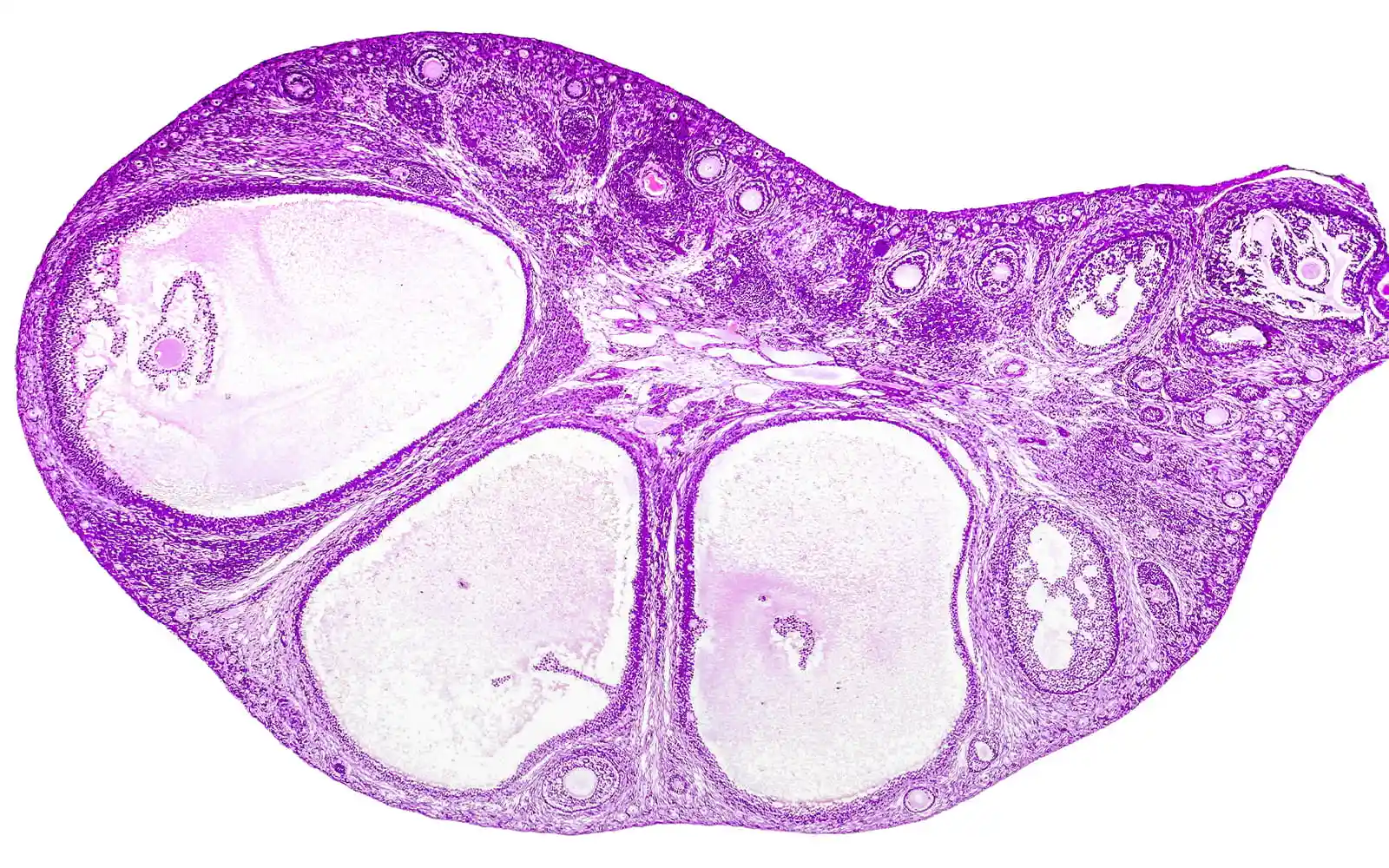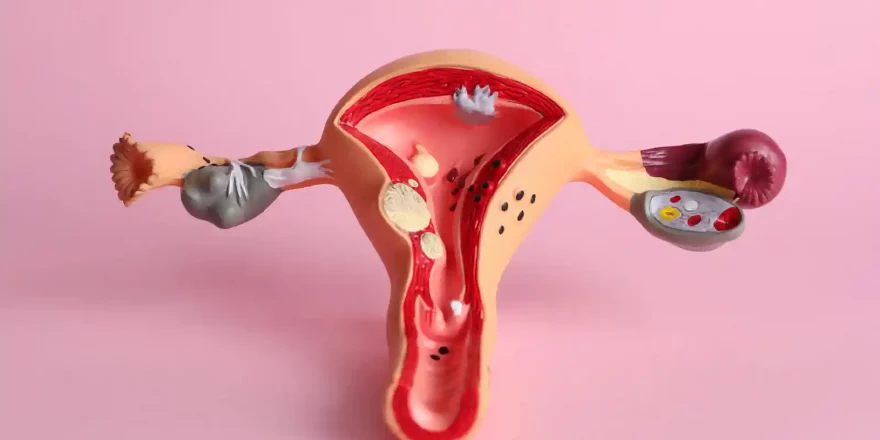Eggs and follicles are core issues for a woman’s fertility, and the only time their numbers increase is during a few months when baby girls are in the womb. The eggs then remain dormant and immature in tiny ‘primordial follicles’ (which are a bit like a “flat-pack” that can safely store eggs for 50 years or more) until puberty.
Once puberty is reached, “batches” of follicles are stimulated by follicle-stimulating hormone (FSH) to continue their development in a process called ‘folliculogenesis’ (follicle formation). This will eventually lead to the largest follicle in each batch (the dominant follicle) releasing a mature egg at ovulation.
- Folliculogenesis takes about 375 days (or thirteen menstrual cycles)
- Fresh ‘groups’ of eggs are recruited each cycle
- Ovaries contain follicles in many stages of development
- However, most eggs in the ovaries are immature and dormant
Follicle numbers vary, but women usually have: i
- 300,000 at 5-7 months gestation (from 35,000 to 2.5 million)
- 250,000 at birth
- 180,000 at puberty (from 25,000 to 1.5 million)
- 1,000 at menopause
Recruitment
The process by which primordial follicles are stimulated is called ‘recruitment’, and various eggs are in the ovaries at different stages of the recruitment process. The stages of follicle development are:
| Follicle Stage | Description | Size (diameter) mm |
|---|---|---|
| Primordial | Dormant | 0.03-0.05 |
| Primary | FSH receptors and the zona pelicida develop | 0.1 |
| Secondary | Blood vessels develop, and the eggs are fully grown | 0.2 |
| Early Tertiary (Antral) | A fluid-filled (antral) cavity develops after about 290 days | 0.2-5.0 |
| Late Tertiary | Recruitment to the menstrual cycle in the follicular phase | 10-16 |
| Pre-ovulatory | One dominant follicle is ready to rupture | 16-20 |
Only follicles at the ‘antral’ stage Class 5 (see below) and above are counted during ultrasound scans.

Fig. 1: A model of follicle growth in humans, where atresia is the percentage of eggs lost in each stage (Source: Gougeon, 1986)
Although girls have many thousands of eggs, only about 400 are ovulated, with very few of them reaching the later stages of development.
Ovulation
When the ‘dominant follicle’ reaches 17-18mm, a ‘surge’ in Luteinizing Hormone (LH) for 24-36 hours “luteinizes” it and triggers crucial changes:
- The egg detaches from the follicle wall
- The follicle rapidly increases in size and a blister forms on the surface
- The blister ruptures and releases the egg in about 15ml of fluid through the ‘stigma’ hole
- The follicle transforms into a corpus luteum, and it now produces progesterone (as well as estrogens)
Ultrasound can show the stigma to confirm the egg’s release, as non-release causes a condition called LUFS. The pictures below show an egg ovulating from the dominant follicle (there’s also a surgical probe in the picture).

Egg quality
Egg quality and follicle health are crucial factors as:
- Large follicles produce estrogen in the first half of the cycle, stimulating the womb lining to grow
- Good quality eggs are more likely to come from good quality follicles
- The dominant follicle becomes the corpus luteum, and low progesterone levels in the second phase are often due to a low-quality dominant follicle
Because of the amount of growth and associated energy needed to transform a primordial follicle into a mature follicle, all eggs that reach the latter stages of growth are exposed to oxidative stress. To a great extent, the number of eggs and their quality reaching maturity reflects how well recruitment was negotiated:
- Recruitment involves massive growth by the follicle around the egg, requiring a lot of energy
- Few eggs survive recruitment, and Fig.1 shows the percentages of eggs “lost” at each stage ii
- The single helix DNA structure in eggs and sperm makes them easily damaged and difficult to repair
As recruitment inevitably ends in few eggs reaching the last stages, it could explain why:
- Teenage girls have tens of thousands of eggs, yet only around 400 get ovulated
- There’s an increased rate of follicle loss after the age of 35, as we’re less able to repair damage to cells as we age iii
- Getting older involves lower conception rates, higher miscarriage rates and more genetic problems
Follicle loss varies during recruitment and is affected by:
- The number of follicles at birth
- The immune state (particularly the presence of anti-ovarian antibodies)
- General health and diet
- Exposure to toxins and oxidative stress
- Emotional stress
- Antioxidant levels in the diet
- Maternal age
- Genetics and gene expression iv
It is possible to improve egg quality and reduce damage to the follicles with changes to diet and lifestyle. Medicinal herbs have been shown to improve egg quality and ovarian function as well as lower FSH levels. v
morefertile PFPs enable greater control of your fertility journey, with improvements in ovarian function typically seen in about three months.
ii ‘Dynamics of follicular growth in the human: a model from preliminary results.’ Gougeon A. Hum Reprod. 1986; 1: 81–87
iii ‘Impairment of BRCA1-related DNA double-strand break repair leads to ovarian ageing in mice and humans.’ Titus S, et al. (2013). Sci Transl Med 5(172):172ra21. doi: 10.1126/scitranslmed.3004925. PMID: 23408054
iv ‘Differential Granulosa Cell Gene Expression in Young Women with Diminished Ovarian Reserve’. K Greenseid et al. Reproductive Sciences, September 2011 vol. 18 no. 9 892-899
v ‘Measuring the effectiveness of Chinese herbal medicine in improving female fertility. Wing T, Sedlmeier E. J Chin Med
2006;80:26—32.



